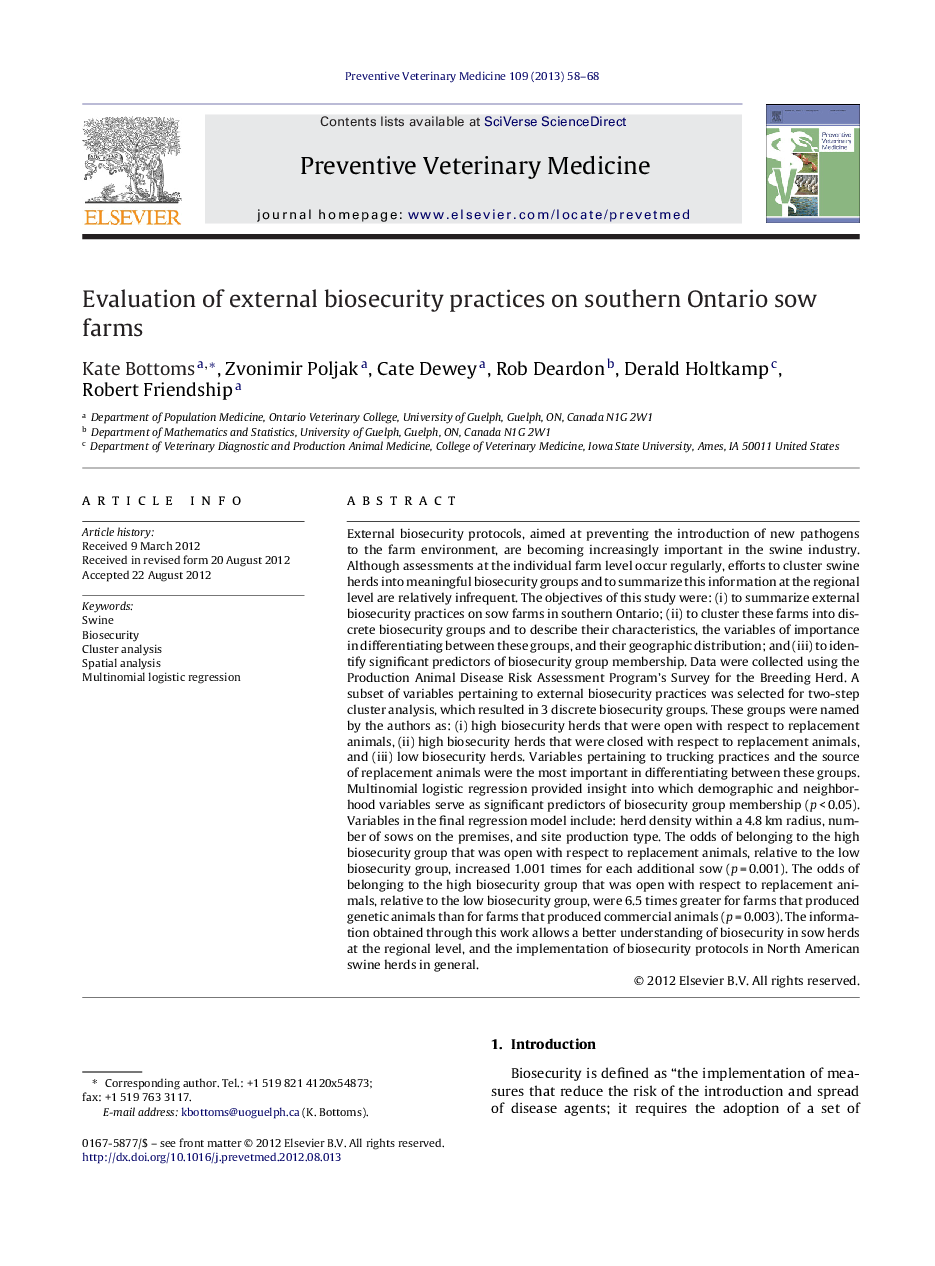| کد مقاله | کد نشریه | سال انتشار | مقاله انگلیسی | نسخه تمام متن |
|---|---|---|---|---|
| 5793929 | 1554184 | 2013 | 11 صفحه PDF | دانلود رایگان |
عنوان انگلیسی مقاله ISI
Evaluation of external biosecurity practices on southern Ontario sow farms
ترجمه فارسی عنوان
ارزیابی شیوه های بیولوژیکی بیرونی در مزارع کاشت جنوب استان انتاریو
دانلود مقاله + سفارش ترجمه
دانلود مقاله ISI انگلیسی
رایگان برای ایرانیان
کلمات کلیدی
سوسیس، بهداشت ایمنی، آنالیز خوشه ای، تجزیه و تحلیل فضایی، رگرسیون لجستیک چند ملیتی،
موضوعات مرتبط
علوم زیستی و بیوفناوری
علوم کشاورزی و بیولوژیک
علوم دامی و جانورشناسی
چکیده انگلیسی
External biosecurity protocols, aimed at preventing the introduction of new pathogens to the farm environment, are becoming increasingly important in the swine industry. Although assessments at the individual farm level occur regularly, efforts to cluster swine herds into meaningful biosecurity groups and to summarize this information at the regional level are relatively infrequent. The objectives of this study were: (i) to summarize external biosecurity practices on sow farms in southern Ontario; (ii) to cluster these farms into discrete biosecurity groups and to describe their characteristics, the variables of importance in differentiating between these groups, and their geographic distribution; and (iii) to identify significant predictors of biosecurity group membership. Data were collected using the Production Animal Disease Risk Assessment Program's Survey for the Breeding Herd. A subset of variables pertaining to external biosecurity practices was selected for two-step cluster analysis, which resulted in 3 discrete biosecurity groups. These groups were named by the authors as: (i) high biosecurity herds that were open with respect to replacement animals, (ii) high biosecurity herds that were closed with respect to replacement animals, and (iii) low biosecurity herds. Variables pertaining to trucking practices and the source of replacement animals were the most important in differentiating between these groups. Multinomial logistic regression provided insight into which demographic and neighborhood variables serve as significant predictors of biosecurity group membership (p < 0.05). Variables in the final regression model include: herd density within a 4.8 km radius, number of sows on the premises, and site production type. The odds of belonging to the high biosecurity group that was open with respect to replacement animals, relative to the low biosecurity group, increased 1.001 times for each additional sow (p = 0.001). The odds of belonging to the high biosecurity group that was open with respect to replacement animals, relative to the low biosecurity group, were 6.5 times greater for farms that produced genetic animals than for farms that produced commercial animals (p = 0.003). The information obtained through this work allows a better understanding of biosecurity in sow herds at the regional level, and the implementation of biosecurity protocols in North American swine herds in general.
ناشر
Database: Elsevier - ScienceDirect (ساینس دایرکت)
Journal: Preventive Veterinary Medicine - Volume 109, Issues 1â2, 1 April 2013, Pages 58-68
Journal: Preventive Veterinary Medicine - Volume 109, Issues 1â2, 1 April 2013, Pages 58-68
نویسندگان
Kate Bottoms, Zvonimir Poljak, Cate Dewey, Rob Deardon, Derald Holtkamp, Robert Friendship,
